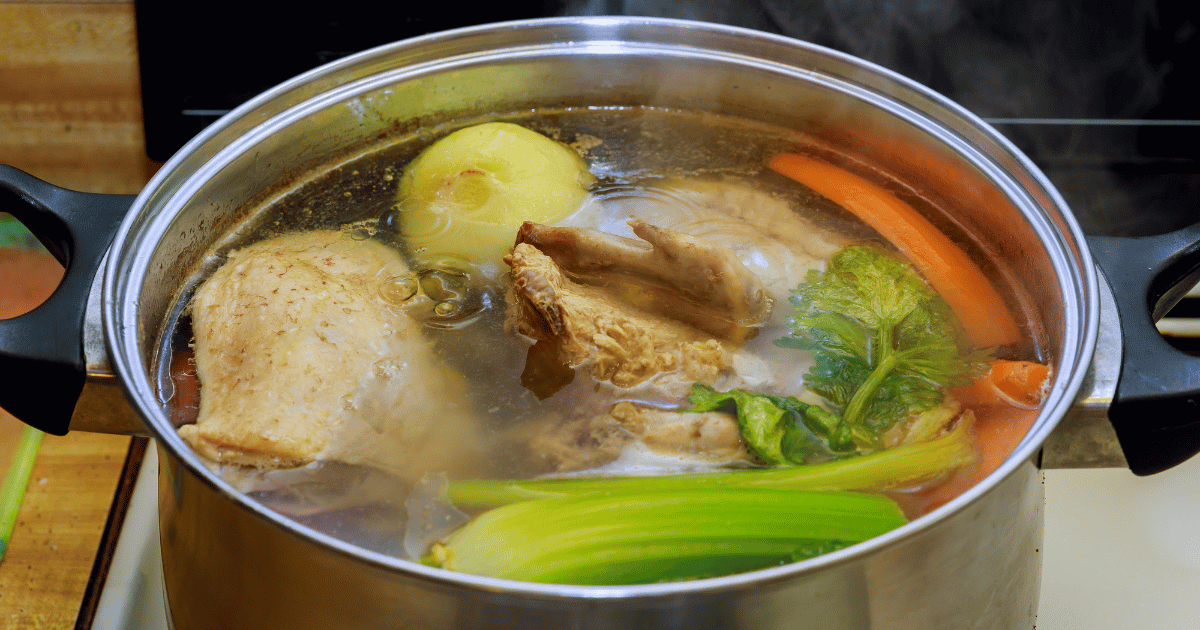
Homemade Pasture-Raised Chicken Stock Recipe : The Foundation of Real Flavor
|
|
Time to read 5 min
|
|
Time to read 5 min
Nothing embodies real, slow food like a pot of homemade chicken stock simmering on the stove. Made from pasture-raised chicken feet, necks, and meaty backs from David’s Pasture, this stock is rich in natural collagen, minerals, and savory depth. This chicken stock recipe is perfect as the base for soups, sauces, gravies, or grains, this recipe captures the essence of real American farming — wholesome ingredients raised right.
At Valor Provisions, we source from trusted farms like David’s Pasture to help you cook with confidence and integrity. This isn’t just broth — it’s the backbone of better meals and a connection to real, pasture-raised quality.
Chicken Stock Recipe : Table of contents

15 mins
8-12 hours (slow simmer)
Yields: About 3–4 quarts of stock
Chicken Stock
United States
1 lb Pasture-Raised Chicken Necks ( Shop Here)
2 lbs Pasture-Raised Meaty Chicken Backs ( Shop Here)
2 carrots, roughly chopped
2 celery stalks, roughly chopped
1 large onion, quartered (skins on for color)
6 garlic cloves, smashed
2 bay leaves
1 tbsp apple cider vinegar (helps extract collagen)
10–12 cups cold water (enough to cover bones by 1–2 inches)
Optional: fresh herbs (parsley, thyme), black peppercorns, sea salt
Rinse all chicken parts under cold water. For chicken feet, consider blanching them in boiling water for 1–2 minutes, then trimming off the outer skin if preferred (optional for clarity).
For a darker, richer stock, roast the chicken feet, necks, and backs on a baking sheet at 425°F for 25–30 minutes until golden brown.
Add all chicken parts to a large stockpot or slow cooker. Layer in the vegetables, bay leaves, garlic, and apple cider vinegar.
Pour in enough cold water to cover all ingredients by about 1–2 inches. Bring the pot to a gentle boil over medium-high heat.
As the stock starts to boil, skim off any foam or impurities that rise to the surface with a spoon. This step keeps your stock clear and clean.
Reduce to a low simmer. Cook uncovered for 8–12 hours (or even up to 24 hours for a more gelatinous texture). Add water as needed to keep ingredients submerged.
Carefully strain the stock through a fine mesh sieve into a large bowl. Discard solids.
Let cool completely, then refrigerate overnight. A layer of natural fat will rise to the top — you can remove or save it for cooking. Store stock in airtight containers for up to 5 days or freeze in jars or cubes for up to 3 months.
David’s Pasture is a multi-generational family farm that believes in raising animals the right way, on open grass, with no antibiotics, and with respect for the land.
Each cut, from the meaty backs to the collagen-rich feet, reflects the farm’s commitment to sustainability and taste. When you cook with Valor Provisions and David’s Pasture, you’re not just making food, you’re investing in the American farm and the flavor of authenticity.
Use cold water: Helps extract gelatin and nutrients gradually.
Add vinegar: The mild acidity pulls minerals from the bones.
Low and slow: Avoid boiling hard — simmer gently for clarity and depth.
Don’t salt too early: Wait until after straining so the flavor doesn’t concentrate too much.
Soup base for chicken noodle, ramen, or creamy chowders
Risotto, quinoa, or rice cooking liquid
Gravy or sauce foundation
Stews and braises for extra richness
Sipping broth for cold days or post-workout recovery
Chicken stock is made primarily from bones (like feet, necks, and backs), simmered for hours to extract collagen and minerals, giving it a richer texture and mouthfeel. Broth is typically made from meat and is lighter and quicker to prepare.
Chicken feet and backs are packed with connective tissue and collagen — the natural components that give homemade stock its thick, silky consistency when cooled. This is what makes pasture-raised cuts so superior to conventional ones.
Yes! For a slow cooker, set on LOW for 12–18 hours. For an Instant Pot, cook on High Pressure for 2 hours, then natural release.
Refrigerated, it lasts up to 5 days. Frozen, it can keep 3–4 months. Ice cube trays are great for small portions.
It’s best to keep stock unsalted. You’ll season later depending on your recipe (soups, sauces, or stews) to maintain control over flavor.
Pasture-raised chickens live healthier lives outdoors, resulting in bones and fat that produce cleaner, more flavorful stock. Supporting farms like David’s Pasture ensures better animal welfare and more nutrient-rich results.
Yes, while the second batch will be lighter in flavor and color, it can still be used for grains, soups, or as a light sipping broth.
When chilled, your stock should gel — that’s the mark of collagen-rich goodness. If it doesn’t, try using more feet or extending your simmer time next time.
